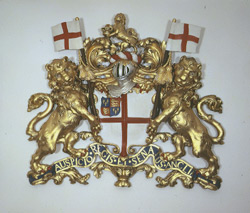England and the Netherlands: the ties between two nations > The VOC and the EIC
The United East Indies Company
The United East Indies Company (in Dutch Vereenigde Oost-Indische Compagnie or VOC for short) was established in 1602, in the first instance for the spice trade. The States-General granted the VOC exclusive trade and navigation rights in Asia and the VOC eventually traded in more than a hundred Asian products. Besides spices, the major products the VOC shipped back to Europe were Indian fabrics, Chinese tea and Javanese coffee.
The Dutch were engaged in fierce competition with the Portuguese, Spanish and English to secure the monopoly of the spice trade. The VOC was empowered to build strongholds, wage war and enter into agreements in the name of the States-General. After a violent war that lasted for some decades, the VOC emerged as victor. All the European competitors had been driven away from the spice-producing areas in the Malacca Islands (that now belong to Indonesia). The populations of a small number of spice islands were forced to sell the entire crop to the Dutch. Everywhere else, the spice trees were uprooted.
Ihis way the VOC made good money in the spice trade for a very long time. The local people benefited as well, since the Dutch paid more than native traders did.
The victims of the VOC monopoly were the inhabitants of the islands where the spice trees had been destroyed and also the middlemen, since the VOC bought the spices direct from the people. In general, the native economy suffered greatly from the Dutch monopoly.
In the eighteenth century, the VOC went downhill. The competition from the French and English increased and the company had to spend a lot of money maintaining all the garrisons as well as the strong fleet which was needed to protect the colonial empire. During the Fourth Anglo-Dutch War (1780-1784), the ships were unable to return to the homeland and this further reduced the already dwindling profits. Payment of dividends was stopped in 1781 and the VOC went into liquidation on 17 March 1798.

The East India Company (EIC)
The East India Company, established in 1600 for the spice trade, was the English counterpart of the VOC. The two companies competed against each other for a monopoly of the European spice markets, a battle which the English lost. As a result, the East India Company focused its activities on Indian products like colourful fabrics and raw silk.
The Ambon murder in 1623 marked the end of the English presence on the Moluccas in the Malay Archipelago, but a couple of months before, the East India Company had already decided to withdraw from the spice trade for want of money.
Though they had to operate from other ports, the English continued to trade very profitably in the area for a long time. In the second quarter of the seventeenth century, the East India Company shipped even more cloves to Europe than the VOC. It was not until 1684, when the Javanese pepper port of Bantam fell into Dutch hands, that most English activities shifted to India.
In the eighteenth century, the East India Company acquired some political influence in India. The company used it to promote its own trading activities. Private English businessmen availed themselves of the EIC’s protection to set up an extensive network on the mainland of Asia. The VOC was unable to cope with so much English competition.
The East India Company was liquidated on 1 January 1874. More than a century later, in 1987, two clever coffee dealers, Tony Wild and David Hutton, founded a new business under the name of the old company and with the same logo. Although the new East India Company is in no way a continuation of the original one, its website mentions that the business was established in 1606.
> Read on: The spice trade
< Go back to: Rivalry
